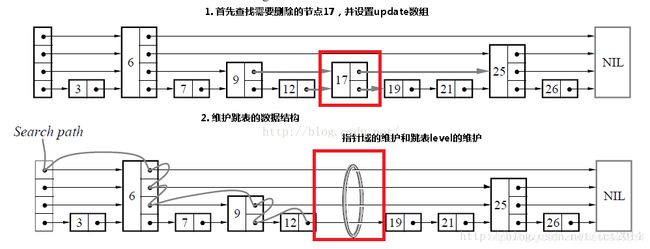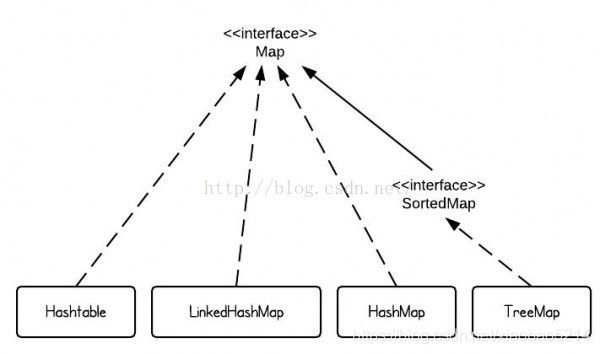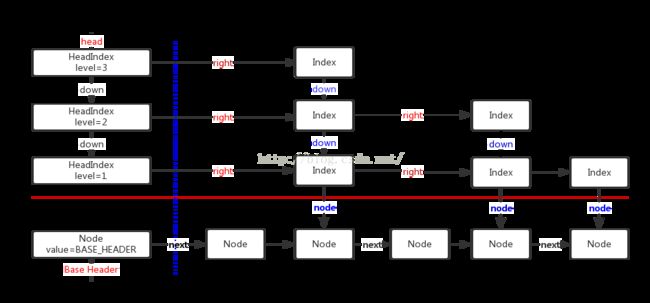跳表(SkipList)及ConcurrentSkipListMap源码解析
二分查找和AVL树查找
二分查找要求元素可以随机访问,所以决定了需要把元素存储在连续内存。这样查找确实很快,但是插入和删除元素的时候,为了保证元素的有序性,就需要大量的移动元素了。
如果需要的是一个能够进行二分查找,又能快速添加和删除元素的数据结构,首先就是二叉查找树,二叉查找树在最坏情况下可能变成一个链表。
于是,就出现了平衡二叉树,根据平衡算法的不同有AVL树,B-Tree,B+Tree,红黑树等,但是AVL树实现起来比较复杂,平衡操作较难理解,这时候就可以用SkipList跳跃表结构。
什么是跳表
传统意义的单链表是一个线性结构,向有序的链表中插入一个节点需要O(n)的时间,查找操作需要O(n)的时间。
跳跃表的简单示例:
如果我们使用上图所示的跳跃表,就可以减少查找所需时间为O(n/2),因为我们可以先通过每个节点的最上面的指针先进行查找,这样子就能跳过一半的节点。
比如我们想查找19,首先和6比较,大于6之后,在和9进行比较,然后在和17进行比较......最后比较到21的时候,发现21大于19,说明查找的点在17和21之间,从这个过程中,我们可以看出,查找的时候跳过了3、7、12等点,因此查找的复杂度为O(n/2)。
查找的过程如下图:
其实,上面基本上就是跳跃表的思想,每一个结点不单单只包含指向下一个结点的指针,可能包含很多个指向后续结点的指针,这样就可以跳过一些不必要的结点,从而加快查找、删除等操作。对于一个链表内每一个结点包含多少个指向后续元素的指针,后续节点个数是通过一个随机函数生成器得到,这样子就构成了一个跳跃表。
随机生成的跳跃表可能如下图所示:
跳跃表其实也是一种通过“空间来换取时间”的一个算法,通过在每个节点中增加了向前的指针,从而提升查找的效率。
“Skip lists are data structures that use probabilistic balancing rather than strictly enforced balancing. As a result, the algorithms for insertion and deletion in skip lists are much simpler and significantly faster than equivalent algorithms for balanced trees. ”
译文:跳跃表使用概率均衡技术而不是使用强制性均衡技术,因此,对于插入和删除结点比传统上的平衡树算法更为简洁高效。
跳表是一种随机化的数据结构,目前开源软件 Redis 和 LevelDB 都有用到它。
SkipList的操作
查找
查找就是给定一个key,查找这个key是否出现在跳跃表中,如果出现,则返回其值,如果不存在,则返回不存在。我们结合一个图就是讲解查找操作,如下图所示:

如果我们想查找19是否存在?如何查找呢?我们从头结点开始,首先和9进行判断,此时大于9,然后和21进行判断,小于21,此时这个值肯定在9结点和21结点之间,此时,我们和17进行判断,大于17,然后和21进行判断,小于21,此时肯定在17结点和21结点之间,此时和19进行判断,找到了。具体的示意图如图所示:
插入
插入包含如下几个操作:1、查找到需要插入的位置 2、申请新的结点 3、调整指针。
我们结合下图进行讲解,查找路径如下图的灰色的线所示 申请新的结点如17结点所示, 调整指向新结点17的指针以及17结点指向后续结点的指针。这里有一个小技巧,就是使用update数组保存大于17结点的位置,update数组的内容如红线所示,这些位置才是有可能更新指针的位置。
删除
删除操作类似于插入操作,包含如下3步:1、查找到需要删除的结点 2、删除结点 3、调整指针
Key-Value数据结构
目前常用的key-value数据结构有三种:Hash表、红黑树、SkipList,它们各自有着不同的优缺点(不考虑删除操作):
Hash表:插入、查找最快,为O(1);如使用链表实现则可实现无锁;数据有序化需要显式的排序操作。
红黑树:插入、查找为O(logn),但常数项较小;无锁实现的复杂性很高,一般需要加锁;数据天然有序。
SkipList:插入、查找为O(logn),但常数项比红黑树要大;底层结构为链表,可无锁实现;数据天然有序。
如果要实现一个key-value结构,需求的功能有插入、查找、迭代、修改,那么首先Hash表就不是很适合了,因为迭代的时间复杂度比较高;而红黑树的插入很可能会涉及多个结点的旋转、变色操作,因此需要在外层加锁,这无形中降低了它可能的并发度。而SkipList底层是用链表实现的,可以实现为lock free,同时它还有着不错的性能(单线程下只比红黑树略慢),非常适合用来实现我们需求的那种key-value结构。
LevelDB、Reddis的底层存储结构就是用的SkipList。
基于锁的并发
优点:
1、编程模型简单,如果小心控制上锁顺序,一般来说不会有死锁的问题;
2、可以通过调节锁的粒度来调节性能。
缺点:
1、所有基于锁的算法都有死锁的可能;
2、上锁和解锁时进程要从用户态切换到内核态,并可能伴随有线程的调度、上下文切换等,开销比较重;
3、对共享数据的读与写之间会有互斥。
无锁编程(lock free)
常见的lock free编程一般是基于CAS(Compare And Swap)操作:CAS(void *ptr, Any oldValue, Any newValue);
即查看内存地址ptr处的值,如果为oldValue则将其改为newValue,并返回true,否则返回false。X86平台上的CAS操作一般是通过CPU的CMPXCHG指令来完成的。CPU在执行此指令时会首先锁住CPU总线,禁止其它核心对内存的访问,然后再查看或修改*ptr的值。简单的说CAS利用了CPU的硬件锁来实现对共享资源的串行使用。
优点:
1、开销较小:不需要进入内核,不需要切换线程;
2、没有死锁:总线锁最长持续为一次read+write的时间;
3、只有写操作需要使用CAS,读操作与串行代码完全相同,可实现读写不互斥。
缺点:
1、编程非常复杂,两行代码之间可能发生任何事,很多常识性的假设都不成立。
2、CAS模型覆盖的情况非常少,无法用CAS实现原子的复数操作。
而在性能层面上,CAS与mutex/readwrite lock各有千秋,简述如下:
1、单线程下CAS的开销大约为10次加法操作,mutex的上锁+解锁大约为20次加法操作,而readwrite lock的开销则更大一些。
2、CAS的性能为固定值,而mutex则可以通过改变临界区的大小来调节性能;
3、如果临界区中真正的修改操作只占一小部分,那么用CAS可以获得更大的并发度。
4、多核CPU中线程调度成本较高,此时更适合用CAS。
跳表和红黑树的性能相当,最主要的优势就是当调整(插入或删除)时,红黑树需要使用旋转来维护平衡性,这个操作需要动多个节点,在并发时候很难控制。而跳表插入或删除时只需定位后插入,插入时只需添加插入的那个节点及其多个层的复制,以及定位和插入的原子性维护。所以它更加可以利用CAS操作来进行无锁编程。
ConcurrentHashMap
JDK为我们提供了很多Map接口的实现,使得我们可以方便地处理Key-Value的数据结构。
当我们希望快速存取
当我们希望在多线程并发存取
TreeMap则会帮助我们保证数据是按照Key的自然顺序或者compareTo方法指定的排序规则进行排序。
OK,那么当我们需要多线程并发存取
也许,我们可以选择ConcurrentTreeMap。不好意思,JDK没有提供这么好的数据结构给我们。
当然,我们可以自己添加lock来实现ConcurrentTreeMap,但是随着并发量的提升,lock带来的性能开销也随之增大。
Don't cry......,JDK6里面引入的ConcurrentSkipListMap也许可以满足我们的需求。
什么是ConcurrentSkipListMap
ConcurrentSkipListMap提供了一种线程安全的并发访问的排序映射表。内部是SkipList(跳表)结构实现,在理论上能够O(log(n))时间内完成查找、插入、删除操作。
存储结构
ConcurrentSkipListMap存储结构跳跃表(SkipList):
1、最底层的数据节点按照关键字升序排列。
2、包含多级索引,每个级别的索引节点按照其关联数据节点的关键字升序排列。
3、高级别索引是其低级别索引的子集。
4、如果关键字key在级别level=i的索引中出现,则级别level<=i的所有索引中都包含key。
注:类比一下数据库的索引、B+树。
public class ConcurrentSkipListMap extends AbstractMap implements ConcurrentNavigableMap,
Cloneable,java.io.Serializable {
/** Special value used to identify base-level header*/
private static final Object BASE_HEADER = new Object();//该值用于标记数据节点的头结点
/** The topmost head index of the skiplist.*/
private transient volatile HeadIndex head;//最高级别索引的索引头
......
/** Nodes hold keys and values, and are singly linked in sorted order, possibly with some intervening marker nodes.
The list is headed by a dummy node accessible as head.node. The value field is declared only as Object because it
takes special non-V values for marker and header nodes. */
static final class Node {//保存键值对的数据节点,并且是有序的单链表。
final K key;
volatile Object value;
volatile Node next;//后继数据节点
......
}
/** Index nodes represent the levels of the skip list.
Note that even though both Nodes and Indexes have forward-pointing fields, they have different types and are handled
in different ways, that can't nicely be captured by placing field in a shared abstract class.
*/
static class Index {//索引节点
final Node node;//索引节点关联的数据节点
final Index down;//下一级别索引节点(关联的数据节点相同)
volatile Index right;//当前索引级别中,后继索引节点
......
}
/** Nodes heading each level keep track of their level.*/
static final class HeadIndex extends Index {//索引头
final int level;//索引级别
HeadIndex(Node node, Index down, Index right, int level) {
super(node, down, right);
this.level = level;
}
}
......
}
查找
//Returns the value to which the specified key is mapped, or null if this map contains no mapping for the key.
public V get(Object key) {
return doGet(key);
}
private V doGet(Object okey) {
Comparable key = comparable(okey);
// Loop needed here and elsewhere in case value field goes null just as it is about to be returned, in which case we
// lost a race with a deletion, so must retry.
// 这里采用循环的方式来查找数据节点,是为了防止返回刚好被删除的数据节点,一旦出现这样的情况,需要重试。
for (;;) {
Node n = findNode(key);//根据key查找数据节点
if (n == null)
return null;
Object v = n.value;
if (v != null)
return (V)v;
}
}
/**Returns node holding key or null if no such, clearing out any deleted nodes seen along the way.
Repeatedly traverses at base-level looking for key starting at predecessor returned from findPredecessor,
processing base-level deletions as encountered. Some callers rely on this side-effect of clearing deleted nodes.
* Restarts occur, at traversal step centered on node n, if:
*
* (1) After reading n's next field, n is no longer assumed predecessor b's current successor, which means that
* we don't have a consistent 3-node snapshot and so cannot unlink any subsequent deleted nodes encountered.
*
* (2) n's value field is null, indicating n is deleted, in which case we help out an ongoing structural deletion
* before retrying. Even though there are cases where such unlinking doesn't require restart, they aren't sorted out
* here because doing so would not usually outweigh cost of restarting.
*
* (3) n is a marker or n's predecessor's value field is null, indicating (among other possibilities) that
* findPredecessor returned a deleted node. We can't unlink the node because we don't know its predecessor, so rely
* on another call to findPredecessor to notice and return some earlier predecessor, which it will do. This check is
* only strictly needed at beginning of loop, (and the b.value check isn't strictly needed at all) but is done
* each iteration to help avoid contention with other threads by callers that will fail to be able to change
* links, and so will retry anyway.
*
* The traversal loops in doPut, doRemove, and findNear all include the same three kinds of checks. And specialized
* versions appear in findFirst, and findLast and their variants. They can't easily share code because each uses the
* reads of fields held in locals occurring in the orders they were performed.
*
* @param key the key
* @return node holding key, or null if no such
*/
private Node findNode(Comparable key) {
for (;;) {
Node b = findPredecessor(key);//根据key查找前驱数据节点
Node n = b.next;
for (;;) {
if (n == null)
return null;
Node f = n.next;
//1、b的后继节点两次读取不一致,重试
if (n != b.next) // inconsistent read
break;
Object v = n.value;
//2、数据节点的值为null,表示该数据节点标记为已删除,移除该数据节点并重试。
if (v == null) { // n is deleted
n.helpDelete(b, f);
break;
}
//3、b节点被标记为删除,重试
if (v == n || b.value == null) // b is deleted
break;
int c = key.compareTo(n.key);
if (c == 0)//找到返回
return n;
if (c < 0)//给定key小于当前可以,不存在
return null;
b = n;//否则继续查找
n = f;
}
}
}
/**Returns a base-level node with key strictly less than given key, or the base-level header if there is no such node.
Also unlinks indexes to deleted nodes found along the way. Callers rely on this side-effect of clearing indices to deleted nodes.
* @param key the key
* @return a predecessor of key */
//返回“小于且最接近给定key”的数据节点,如果不存在这样的数据节点就返回最低级别的索引头。
private Node findPredecessor(Comparable key) {
if (key == null)
throw new NullPointerException(); // don't postpone errors
for (;;) {
Index q = head;//从顶层索引开始查找
Index r = q.right;
for (;;) {
if (r != null) {
Node n = r.node;
K k = n.key;
if (n.value == null) {//数据节点的值为null,表示该数据节点标记为已删除,断开连接并重试
if (!q.unlink(r))
break; // restart
r = q.right; // reread r
continue;
}
if (key.compareTo(k) > 0) {//给定key大于当前key,继续往右查找
q = r;
r = r.right;
continue;
}
}
//执行到这里有两种情况:
//1、当前级别的索引查找结束
//2、给定key小于等于当前key
Index d = q.down;//在下一级别索引中查找
if (d != null) {//如果还存在更低级别的索引,在更低级别的索引中继续查找
q = d;
r = d.right;
} else
return q.node;//如果当前已经是最低级别的索引,当前索引节点关联的数据节点即为所求
}
}
}
插入
/**
* Associates the specified value with the specified key in this map.
* If the map previously contained a mapping for the key, the old value is replaced.
*
* @param key key with which the specified value is to be associated
* @param value value to be associated with the specified key
* @return the previous value associated with the specified key, or
* null if there was no mapping for the key
* @throws ClassCastException if the specified key cannot be compared
* with the keys currently in the map
* @throws NullPointerException if the specified key or value is null
*/
public V put(K key, V value) {
if (value == null)
throw new NullPointerException();
return doPut(key, value, false);
}
/**
* Main insertion method. Adds element if not present, or replaces value if present and onlyIfAbsent is false.
* @param kkey the key
* @param value the value that must be associated with key
* @param onlyIfAbsent if should not insert if already present
* @return the old value, or null if newly inserted
*/
private V doPut(K kkey, V value, boolean onlyIfAbsent) {
Comparable key = comparable(kkey);
for (;;) {
Node b = findPredecessor(key);//查找前驱数据节点
Node n = b.next;
for (;;) {
if (n != null) {
Node f = n.next;
//1、b的后继两次读取不一致,重试
if (n != b.next) // inconsistent read
break;
Object v = n.value;
//2、数据节点的值为null,表示该数据节点标记为已删除,移除该数据节点并重试。
if (v == null) { // n is deleted
n.helpDelete(b, f);
break;
}
//3、b节点被标记为已删除,重试
if (v == n || b.value == null) // b is deleted
break;
int c = key.compareTo(n.key);
if (c > 0) {//给定key大于当前可以,继续寻找合适的插入点
b = n;
n = f;
continue;
}
if (c == 0) {//找到
if (onlyIfAbsent || n.casValue(v, value))
return (V)v;
else
break; // restart if lost race to replace value
}
// else c < 0; fall through
}
//没有找到,新建数据节点
Node z = new Node(kkey, value, n);
if (!b.casNext(n, z))
break; // restart if lost race to append to b
int level = randomLevel();//随机的索引级别
if (level > 0)
insertIndex(z, level);
return null;
}
}
}
/**
* Creates and adds index nodes for the given node.
* @param z the node
* @param level the level of the index
*/
private void insertIndex(Node z, int level) {
HeadIndex h = head;
int max = h.level;
if (level <= max) {//索引级别已经存在,在当前索引级别以及底层索引级别上都添加该节点的索引
Index idx = null;
for (int i = 1; i <= level; ++i)//首先得到一个包含1~level个索引级别的down关系的链表,最后的inx为最高level索引
idx = new Index(z, idx, null);
addIndex(idx, h, level);//Adds given index nodes from given level down to 1.新增索引
} else { // Add a new level 新增索引级别
/* To reduce interference by other threads checking for empty levels in tryReduceLevel, new levels are added
* with initialized right pointers. Which in turn requires keeping levels in an array to access them while
* creating new head index nodes from the opposite direction. */
level = max + 1;
Index[] idxs = (Index[])new Index[level+1];
Index idx = null;
for (int i = 1; i <= level; ++i)
idxs[i] = idx = new Index(z, idx, null);
HeadIndex oldh;
int k;
for (;;) {
oldh = head;
int oldLevel = oldh.level;//更新head
if (level <= oldLevel) { // lost race to add level
k = level;
break;
}
HeadIndex newh = oldh;
Node oldbase = oldh.node;
for (int j = oldLevel+1; j <= level; ++j)
newh = new HeadIndex(oldbase, newh, idxs[j], j);
if (casHead(oldh, newh)) {
k = oldLevel;
break;
}
}
addIndex(idxs[k], oldh, k);
}
}







